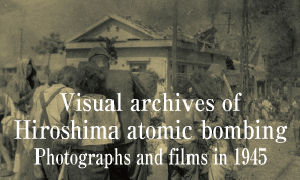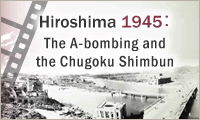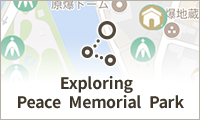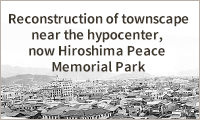Documenting Hiroshima of 1945: Mid-to-late September, Canna lilies bloom amid ruins, offering hope
Sep. 18, 2024
by Maho Yamamoto, Staff Writer
In mid-to-late September 1945, after the Makurazaki typhoon had passed through, Canna lilies bloomed next to the rubble of the former Chugoku Military District Artillery Reserve (in present-day area of Motomachi, in Hiroshima’s Naka Ward), located around 800 meters north of the hypocenter. Eiichi Matsumoto, a photographer in the publications department at the Asahi Shimbun’s Tokyo head office who died in 2004 at the age of 89, took photographs of the Canna lilies between September 18 and 25th, 1945.
Mr. Matsumoto had been charged with taking photos in the two A-bombed cities for the company’s magazine Kagaku Asahi (in English, ‘Asahi Science’). In a personal account he wrote, “Such a rumor that the land would be barren for the next 70 years, with no grass or trees growing, was going around at the time as if it were true.” With eerie uncertainty about the idea of “biological infertility” lasting 70 years, which had originated from comments made by a U.S. scientist, he headed for the A-bombed cities.
Starting on August 25, he took photos in Nagasaki City. After that, on his way to Hiroshima City by train, he found himself stranded in Yamaguchi Prefecture because of the Makurazaki Typhoon but ultimately made it to the city by boat. Looking at the devastation on a scale that seemed improbable from a single bomb, he wrote, “Here, I was faced with the same astonishment I had previously experienced in Nagasaki.”
About the Canna lilies, which added a touch of color to the scorched plain, he remarked how, “I took the photo without much thought, feeling something remarkable about the scene.” In 2002, at the time its exhibits were updated, the Hiroshima Peace Memorial Museum displayed the photo at the end of an exhibition depicting the reality of the atomic bombing held in its Main Building.
Minoru Hataguchi, 78, director of museum at that time who now lives in Hatsukaichi City, Hiroshima Prefecture, explained the aim of the exhibition. “We were looking for something that would give hope to visitors looking at the exhibits.” The photo is still on display on the basement floor of the museum’s East Building, with descriptions both in Japanese and English communicating how the revived greenery in the scorched ruins had restored people’s courage and hope to live.
Mr. Hataguchi experienced the atomic bombing in his mother’s womb and lost his father Jiro, 31 at the time, to the bombing. “Amid her own hopelessness, my mother worked tirelessly to raise me.” Even as the greenery amid the ruins gave citizens hope for recovery, the rebuilding of their lives and the city would involve great hardship.
(Originally published on September 18, 2024)
In mid-to-late September 1945, after the Makurazaki typhoon had passed through, Canna lilies bloomed next to the rubble of the former Chugoku Military District Artillery Reserve (in present-day area of Motomachi, in Hiroshima’s Naka Ward), located around 800 meters north of the hypocenter. Eiichi Matsumoto, a photographer in the publications department at the Asahi Shimbun’s Tokyo head office who died in 2004 at the age of 89, took photographs of the Canna lilies between September 18 and 25th, 1945.
Mr. Matsumoto had been charged with taking photos in the two A-bombed cities for the company’s magazine Kagaku Asahi (in English, ‘Asahi Science’). In a personal account he wrote, “Such a rumor that the land would be barren for the next 70 years, with no grass or trees growing, was going around at the time as if it were true.” With eerie uncertainty about the idea of “biological infertility” lasting 70 years, which had originated from comments made by a U.S. scientist, he headed for the A-bombed cities.
Starting on August 25, he took photos in Nagasaki City. After that, on his way to Hiroshima City by train, he found himself stranded in Yamaguchi Prefecture because of the Makurazaki Typhoon but ultimately made it to the city by boat. Looking at the devastation on a scale that seemed improbable from a single bomb, he wrote, “Here, I was faced with the same astonishment I had previously experienced in Nagasaki.”
About the Canna lilies, which added a touch of color to the scorched plain, he remarked how, “I took the photo without much thought, feeling something remarkable about the scene.” In 2002, at the time its exhibits were updated, the Hiroshima Peace Memorial Museum displayed the photo at the end of an exhibition depicting the reality of the atomic bombing held in its Main Building.
Minoru Hataguchi, 78, director of museum at that time who now lives in Hatsukaichi City, Hiroshima Prefecture, explained the aim of the exhibition. “We were looking for something that would give hope to visitors looking at the exhibits.” The photo is still on display on the basement floor of the museum’s East Building, with descriptions both in Japanese and English communicating how the revived greenery in the scorched ruins had restored people’s courage and hope to live.
Mr. Hataguchi experienced the atomic bombing in his mother’s womb and lost his father Jiro, 31 at the time, to the bombing. “Amid her own hopelessness, my mother worked tirelessly to raise me.” Even as the greenery amid the ruins gave citizens hope for recovery, the rebuilding of their lives and the city would involve great hardship.
(Originally published on September 18, 2024)






